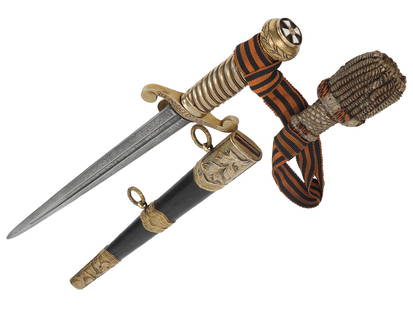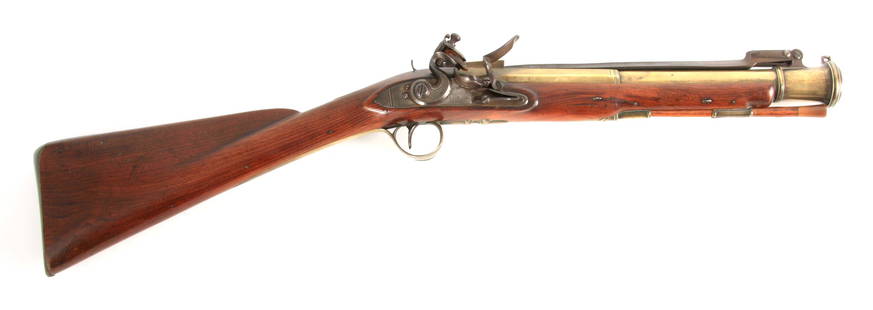
George S. Patton Writes to His Mother from Luxury Liner
Similar Sale History
View More Items in Weapons & ArmorRelated Weapons & Armor
More Items in Weapons & Armor
View MoreRecommended Collectibles
View More





Item Details
Description
Autograph Letter Signed, to his mother, Ruth Wilson Patton, July [June] 1, 1917, aboard RMS Baltic, Atlantic Ocean. 2 pp., 5" x 8". With envelope addressed by Patton to his mother, in care of his father-in-law in Massachusetts. Label affixed to envelope reads “OPENED BY CENSOR.” Expected folds; very good.
Complete Transcript
On board R·M·S·“Baltic.”
July [June] 1 1917
Dear Mama:
I was sorry to make you feel so badly by coming on this trip but we would both have felt worse had I not come.
Things so far have been very stupid and with out interest and it has been very foggy ever since we started and quite cold.
However every one is cheerful and no one has been sea sick as it is very smooth.
Lilian Gish the movie queen is on board and not so much to look at after all.
I have no other news but will write again before we land.
Give my love to all
Your devoted son
George
[Envelope:]
Mrs. Geo. S. Patton
c/o Frederick Ayer
Pride’s Crossing
Mass.
Historical Background
By 1917, George S. Patton had graduated from West Point, competed in the Olympics in Sweden, redesigned U.S. cavalry combat, designed a new sword for those tactics, and battled Mexican bandits. In 1910, he had married Beatrice Banning Ayer (1886-1953), the accomplished and highly educated daughter of a Boston industrialist, and they had two daughters by 1917. In late May 1917, Patton traveled to Europe as an aide to General John J. Pershing (1860-1948), commander of the American Expeditionary Force.
They left New York on May 28 aboard the RMS Baltic. The RMS Baltic was one of the “Big Four” of the White Star Line, some of the world’s largest ships. All four of these British luxury ocean liners were refitted for military service as transport ships during World War I.
During the voyage, officers received instruction in French for two hours daily. As Patton was already reasonably fluent in French, he gave French classes to the enlisted men. On May 29, he wrote in his diary, “The boat has about a hundred trucks on her and several ‘tanks’ without the armor she would surely be a fine prize for a U-boat.” On June 3, he recorded, “Got civilian clothes for all members of the expedition.... The idea is that if we are torpedoed the Germans will be less likely to shell the boats if they see no uniforms.... The temperature of the sea which has been 52F is now 60 which will be a comfort if we have to get in it.” They reached Liverpool on June 8, and after spending some time in London, went on to France by June 14.
Also aboard the RMS Baltic was Lillian Gish (1893-1993), an American actress of both stage and screen. She is best known for her roles in silent films from 1912 into the 1920s. Gish was traveling to Europe to film Hearts of the World, a silent propaganda film written, produced, and directed by D. W. Griffith (1875-1948), and starring Gish, her younger sister Dorothy Gish (1898-1968), and Robert Harron (1893-1920). Griffith filmed exterior scenes throughout England from May to October 1917, and Griffith made two trips to France for footage of the trenches. Interior scenes were shot on a stage in Los Angeles in November and December 1917, and the film was released in March 1918. Gish also starred in The Great Love, another D. W. Griffith silent war drama released in August 1918. Like Hearts of the World, exterior scenes for The Great Love were filmed in England.
On June 22, Patton took his first flight, in a Farman biplane at the flying grounds: “I had always thought it would frighten me but it did not one feels perfectly safe and the machine seems as steady as a church.”
George S. Patton Jr. (1885-1945) was born in California and educated at the Virginia Military Institute and United States Military Academy, from which he graduated in 1909. An avid horseback rider, he was commissioned a second lieutenant in the cavalry. In 1910, he married Beatrice Banning Ayer (1886-1953), the daughter of a wealthy Boston businessman. He competed in the 1912 Olympics in Stockholm, Sweden, in the modern pentathlon, where he finished fifth behind four Swedes. He then traveled to France, where he learned fencing techniques. Returning to the United States, he redesigned cavalry saber combat doctrine and designed a new sword. In 1915 and 1916, Patton participated in the Pancho Villa Expedition in Mexico as Commander John J. Pershing’s aide. In the spring of 1917, he accompanied Pershing, commander of the American Expeditionary Force in World War I, to Europe. Patton took an interest in tanks and was soon training crews to operate them. By 1918, he was in command of a tank brigade. After World War I, he served in various army posts and began to develop the methods of mechanized warfare. At the beginning of World War II, Patton worked to develop and train armored divisions in the army. In the summer of 1942, he commanded the Western Task Force in the Allied invasion of French North Africa. He commanded the Seventh U.S. Army in the successful invasion of Sicily in July 1943. After the Normandy invasion of June 1944, Patton’s Third Army sailed to France and formed on the extreme right of Allied land forces. Through speed and aggressive offensive action, the Third Army continuously pressed retreating German forces until it ran out of fuel near Metz in northeastern France at the end of August. When the German army counterattacked in the battle of the Bulge in mid-December 1944, Patton’s ability to reposition six full divisions to relieve besieged Allied forces in Bastogne was one of the most remarkable achievements of the war. As the Germans retreated, Patton’s Third Army advanced, killing, wounding, or capturing 240,000 German soldiers in seven weeks before crossing the Rhine on March 22. After the end of the war in Europe, Patton hoped for a command in the Pacific but after a visit to the United States returned to Europe for occupation duty in Bavaria. In December 1945, the car in which he was riding collided with an American army truck at low speed, but Patton hit his head on a glass partition, breaking his neck and paralyzing him. He died twelve days later at a hospital in Germany. He was buried among some of his men of the Third Army in an American cemetery in Luxembourg.
Ruth Wilson Patton (1861-1928) was born in California. Her father was a pioneer and real estate developer in southern California, serving as mayor of Pueblo de Los Angeles around 1850. She married George William Patton (1856-1927), the son of a Confederate colonel and graduate of the Virginia Military Institute, in 1884. They settled at Lake Vineyard, California, where they raised produce and operated a winery. In 1902, he began working for Henry E. Huntington’s real estate development company, and he served as the first mayor of San Marino from 1913 to April 1922 and again from October 1922 to 1924. They had two children, George S. Patton Jr. and Anne Wilson Patton (1887-1971).
WE PROVIDE IN-HOUSE SHIPPING WORLDWIDE.
Buyer's Premium
- 25%
George S. Patton Writes to His Mother from Luxury Liner
Shipping & Pickup Options
Item located in Westport, CT, usPayment












































































![George Washington Signed Discharge: Partly printed discharge document signed by George Washington, as Commander in Chief of the Armies of the United States. Newburgh, [New York], 4 January 1783. 1 page, ## x ## in. Undersigned by Washin](https://p1.liveauctioneers.com/7226/322253/173251475_1_x.jpg?height=310&quality=70&version=1710004847)
![[Ambrotype] Texas Confederate Soldier: Sixth plate ambrotype. Full leatherette case. Portrait of a possible Texas Confederate soldier. A silver star device was used to pin up the brim of his light-toned headgear, a look often seen in image](https://p1.liveauctioneers.com/7226/322253/173251509_1_x.jpg?height=310&quality=70&version=1710004847)


![Captured Bowie Knife w/ Period Note of Provenance: Captured Confederate D-hilt Bowie knife. [Kenansville, North Carolina]: [Louis Froelich factory]. With original metal and leather sheath with affixed period notes. First note with only remnants. Secon](https://p1.liveauctioneers.com/7226/325455/175169154_1_x.jpg?height=310&quality=70&version=1712370394)
